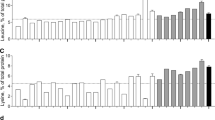Summary
In vivo phosphorus nuclear magnetic resonance spectroscopy of muscle was performed at rest, during work and during postexercise recovery in rats injected with iodo-acetate (IA) (35–40 mg· kg−1, intra-arterially), in order to follow bio-energetic changes in muscle with acute glycolytic block. Three animals with contracture had very low ratios of phosphocreatine: inorganic phosphate (PCr∶Pi) at rest (0.5–0.9). The PCr∶Pi were normal at rest (6.9±2.0,±2 SD) in all other rats. Exercise-induced continuous accumulation of phosphomonoesters (PME), the characteristic finding of glycolytic block, was observed. The end-exercise levels of PME correlated with the degree of block measured in vitro. During steady-state work, induced by nerve stimulation at four frequencies, PCr∶Pi values were significantly lower (p<0.02) than the control values at 0.25, 1.0 and 2.0 Hz. The ATP levels fell during exercise to reach 75%±7% of initial values. The recovery of PCr∶Pi from exercise and the disappearance of PME were slow. Two animals which survived the IA injection demonstrated much lower PME accumulation 18 h later. It is concluded that in acute muscle glycolytic block: (1) energy metabolism is impaired during exercise and also at rest, (2) accumulating PME can serve as an indicator of the degree of glycolytic block, (3) ATP levels fall during work, and (4) postexercise recovery is slow. The findings are compared with31P-NMR observations in chronic muscle glycolytic disorders.
Similar content being viewed by others
References
Argov Z, Bank WJ, Boden B, Roy H, Chance B (1987a) Muscle 31-P NMR in partial glycolytic block: in vivo study of phosphoglycerate mutase deficient patient. Arch Neurol 44:614–617
Argov Z, Bank W, Maris J, Leigh JS Jr, Chance B (1987b) Muscle energy metabolism in human phosphofructokinase deficiency as recorded by 31-P NMR. Ann Neurol 22:46–51
Argov Z, Maris J, Damico L, Koruda M, Roth Z, Leigh JS Jr, Chance B (1987c) Continuous, graded steady state muscle work in rats studied by in vivo 31 P NMR. J Appl Physiol 63:1428–1433
Brumback R (1980) Iodoacetate inhibition of glyceraldehyde-3-phosphate dehydrogenase as a model of human myophosphorylase deficiency (McArdle's disease) and phosphofructokinase deficiency (Tarui's disease). J Neurol Sci 48:383–398
Chance B (1984) Application of 31-P NMR to clinical biochemistry. Ann NY Acad Sci 428:318–332
Chance B, Eleff S, Leigh JS Jr, Sokolov D, Sapega A (1981) Mitochondrial regulation of phosphocreatine/inorganic phosphate ratios in exercising human muscle: a gated 31-P NMR study. Proc Natl Acad Sci USA 78:6714–6718
Chance B, Eleff S, Bank WJ, Leigh JS Jr, Warnell R (1982) 31-P NMR studies of control of mitochondrial function in phosphofructokinase-deficient human skeletal muscle. Proc Natl Acad Sci USA 79:7714–7718
DiMauro S, Bresolin N, Hays AP (1984) Disorders of glycogen metabolism in muscle. CRC Crit Rev Clin Neurobiol 1:83–116
Duboc D, Jenhenson P, Tran Dinh S, Marsac C, Syrota A, Fardeau M (1987) Phosphorus NMR spectroscopy study of muscular enzyme deficiencies involving glycogenolysis and glycolysis. Neurology 37:663–673
Edwards RHT, Dawson DJ, Wilkie DR, Gordon RE, Show D (1982) Clinical use of magnetic resonance in the investigation of myopathy. Lancet i: 725–730
Gibbs C (1985) The cytoplasmic phosphorylation potential. J Mol Cell Cardiol 17:727–731
Giger U, Argov Z, Schnall M, Chance B (1989) Metabolic myopathy in a canine model for muscle-type phosphofructokinase deficiency. Muscle Nerve (in press)
Kuwabara T, Yuasa T, Miyatake T (1986) 31-P NMR studies on an animal model of human defective muscle glycolysis. Muscle Nerve 9:138–143
Layzer RB, Rowland LP, Ranney HM (1967) Muscle phosphofructokinase deficiency. Arch Neurol 17:512–523
Maxwell LC, Barclay JK, Mohrman DE, Faulkner JA (1977) Physiological characteristics of skeletal muscles of dogs and cats. Am J Physiol 233:C14-C18
Mineo I, Kono N, Shimizu T, Hara N, Yamada Y, Sumi S, Nonaka K, Tarui S (1985) Excess purine degradation in exercising muscles of patients with glycogen storage disease types 5 and 7. J Clin Invest 76:556–560
Taylor DJ, Bore PJ, Styles P, Gadian DG, Radda GK (1983) Bioenergetics of intact human muscle. A gated31P NMR study. Mol Biol Med 1:77–94
Veech RL, Lawson JWR, Cornell NW, Krebs AH (1979) Cytosolic phosphorylation potential. J Biol Chem 254:6538–6547
Webb JL (1966) Enzyme and metabolic inhibitors. Academic Press, New York, pp 1–283
Author information
Authors and Affiliations
Rights and permissions
About this article
Cite this article
Argov, Z., Nagle, D., Giger, U. et al. Muscle bio-energetics in acute glycolytic block: in vivo phosphorus-nuclear magnetic resonance study of iodo-acetate injected rats. Europ. J. Appl. Physiol. 58, 808–815 (1989). https://doi.org/10.1007/BF02332211
Accepted:
Issue Date:
DOI: https://doi.org/10.1007/BF02332211




